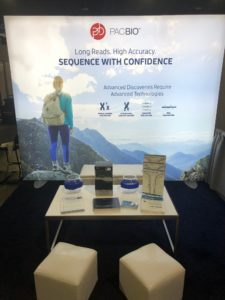
As usual, the PacBio team was out in force for the AACR conference. We attended talks, presented posters, and greeted fellow attendees at our booth. One of our favorite moments occurred during a presentation from AACR Program Committee Chair John Carpten, director of the Institute of Translational Genomics at the University of Southern California, when he called for combining long-read technologies like ours with short-read and other tools to generate new insights into structural variants and specific gene isoforms in cancer.
Indeed, several posters and talks focused on exactly these applications. First, Remond Fijneman from the Netherlands Cancer Institute presented a poster, “Characterization of structural variants within MACROD2 in the pathogenesis of colorectal cancer,” which detailed that MACROD2 is affected by structural variants in >40% of colorectal cancers and >70% of metastases, but only very rarely in colorectal adenomas. Fijneman showed preliminary data indicating that target capture sequencing with PacBio has promise for providing more detailed information on the nature and variability of these deletions.
PacBio scientist Aaron Wenger shared a preliminary analysis of a collaboration with researchers at Radbound University Medical Center and University Medical Center Utrecht aimed at developing a robust truth set of structural variant calls in a cancer cell line. The poster, “Structural variant detection with long read sequencing reveals driver and passenger mutations in a melanoma cell line,” details the range of variants that can be identified with the PacBio structural variant calling pipeline, and reviews in silico experiments to estimate appropriate coverage levels for structural variant discovery in cancer samples.
There were also several presentations on the Iso-Seq method. PacBio’s Brendan Galvin presented “Full-length transcriptome sequencing of melanoma cell line complements long-read assessment of genomic rearrangements,” detailing recent improvements in the Iso-Seq workflow to reduce sample input requirements and sample prep time, and speed up Iso-Seq analysis to work with larger volumes of data. Finally, 2017 SMRT Grant winner Andrew Ludlow gave a talk on his work using the Iso-Seq method to understand the role of NOVA1 in telomere biology during cancer development. His talk is available as part of the AACR 2019 Annual Meeting Webcast.
Finally, Neil Vasan from Memorial Sloan Kettering Cancer Center presented a compelling poster on his work using PacBio amplicon sequencing to understand differences in treatment response, “Double PIK3CA mutations in cis enhance oncogene activation and sensitivity to PI3K alpha inhibitors in breast cancer.” By retrospectively sequencing full-length PIK3CA in patients receiving PIK3CA inhibitor therapy, Vasan found that 10% to 15% of patents have double mutations, and that these are predominantly present in cis. Importantly, compound mutations are predictive of increased sensitivity to inhibitor treatment.
If you attended AACR, we hope you had an informative and fun time too!